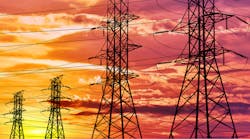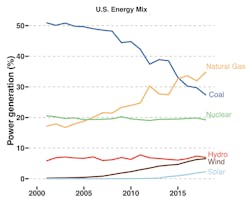The U.S. energy system has seen sweeping changes in the past two decades. Natural gas replaced coal as the dominant source of power generation, and wind and solar energy now contribute roughly 9% of the nation’s electricity, compared to almost none 20 years ago. Because of these changes, less carbon is emitted per unit of electricity produced. For better or worse, a transition toward a low-carbon power sector has begun.
But if the U.S. is to use fewer fossil fuels for power, that means it will need new sources of energy and also an updated grid that can deliver that “clean” power to consumers and industry. Researchers at Carnegie Mellon University’s Engineering and Public Policy (EPP) department recently looked at the what the new grid might look like and why.
Wind and solar are now the cheapest ways to produce energy in many parts of the country, with costs expected to continue to fall. However, places where that energy is in high demand, such as big cities and heavy industrial sites, are far from good sites for wind and solar plants. To make the most of renewable energy, the already-taxed grid must be expanded.
This graph shows the changes in U.S. power generation from 2001-2018. (Source: Power Sector Carbon Index, Scott Institute)
One way to expand the capacity of a transmission corridor is to string more or thicker wires, but it’s expensive. Power lines are heavy, and adding more wire would require building additional supports and acquiring the land on which to build those supports.
Simply sending more current through existing wires to increase the capacity of a corridor may not be an appealing way to increase capacity, either. The increased current causes additional heating within wires, which can make them sag too low, creating potential fire hazards as they droop nearer to the ground or treetops.
Building new corridors from scratch would also increase the grid’s overall carrying capacity, but this would require new land, towers, and wires, all of which are costly. For projects spanning hundreds of miles, it’s also a task fraught with political difficulties. For many people, transmission lines are unsightly and require siting structures on private property. High-profile transmission projects, such as the Plains & Eastern line that was designed to move thousands of megawatts of wind-generated electricity from the Oklahoma panhandle to the southeastern grid, have stalled in recent years due to political opposition and conflicts with landowners.
The researchers also looked into expanding capacity with technology, by switching from predominantly used alternating current (AC) to direct current (DC). The main finding of their work is that, for many corridors, converting from high-voltage AC (HVAC) to high-voltage DC (HVDC) can be the most cost-effective way to deliver more electricity. This is an option generally not considered by utility companies.
One advantage of the HVDC option is that it uses the same wires and much of the same structure while increasing the corridor’s capacity of the corridor.
Switching current from AC to DC lets a given line operate at a higher voltage without increasing the current, which avoids the problem of increased line sag from extra heating.
High-voltage DC has traditionally only been considered a viable option for extremely long corridors, but the team’s work shows the conversion to be the cheapest way to increase capacity for many distances—even as low as 200 miles—challenging the conventional wisdom about HVDC.
But there are costs associated with going from HVAC to HVDC. Additional inverter equipment is required to switch electrical current from DC to AC before being delivered to consumers at the end of the lines, a significant additional capital cost. The team expects this equipment to come down in cost in the coming years, which would make the argument for HVDC conversions even more compelling than current estimates.


